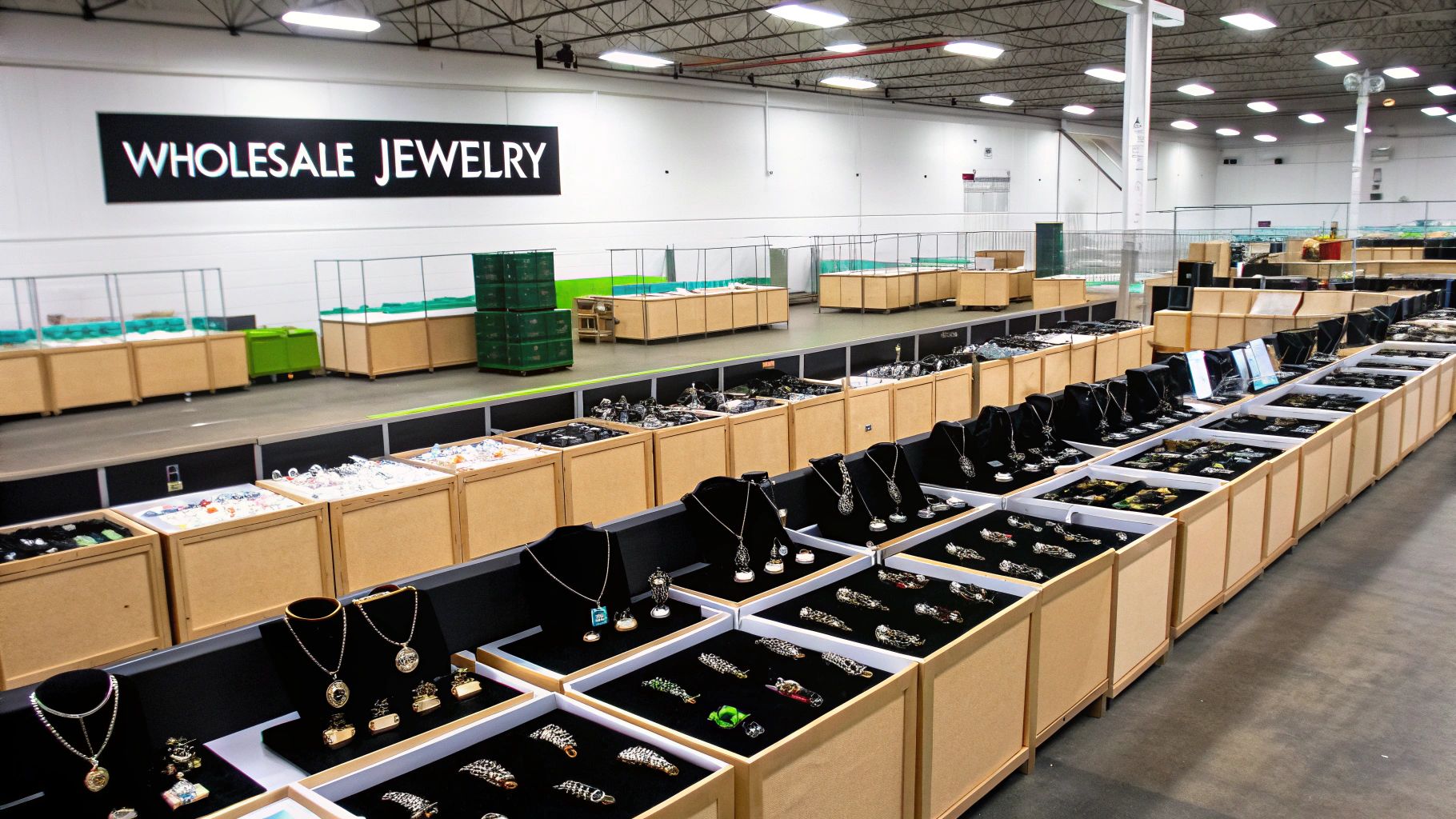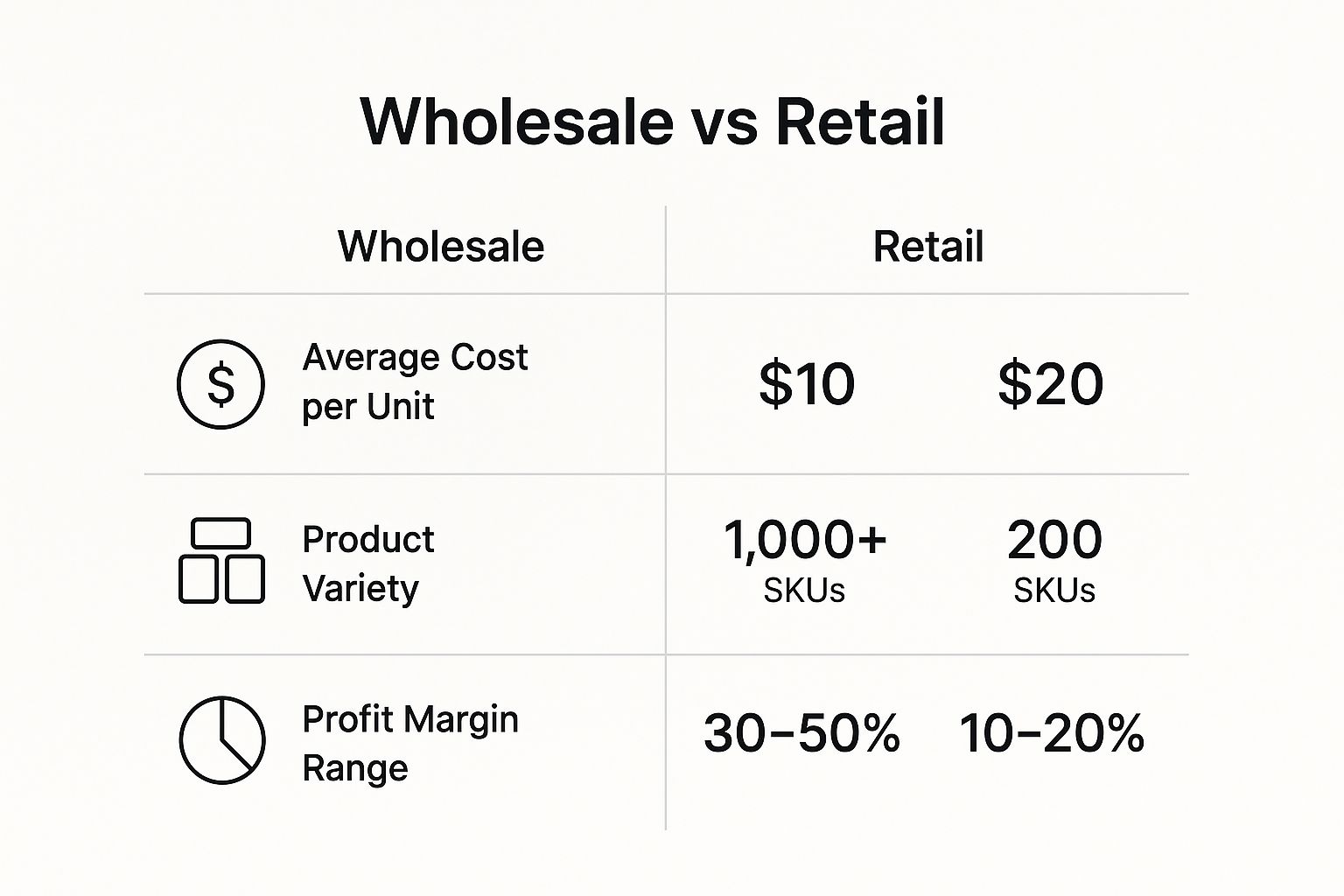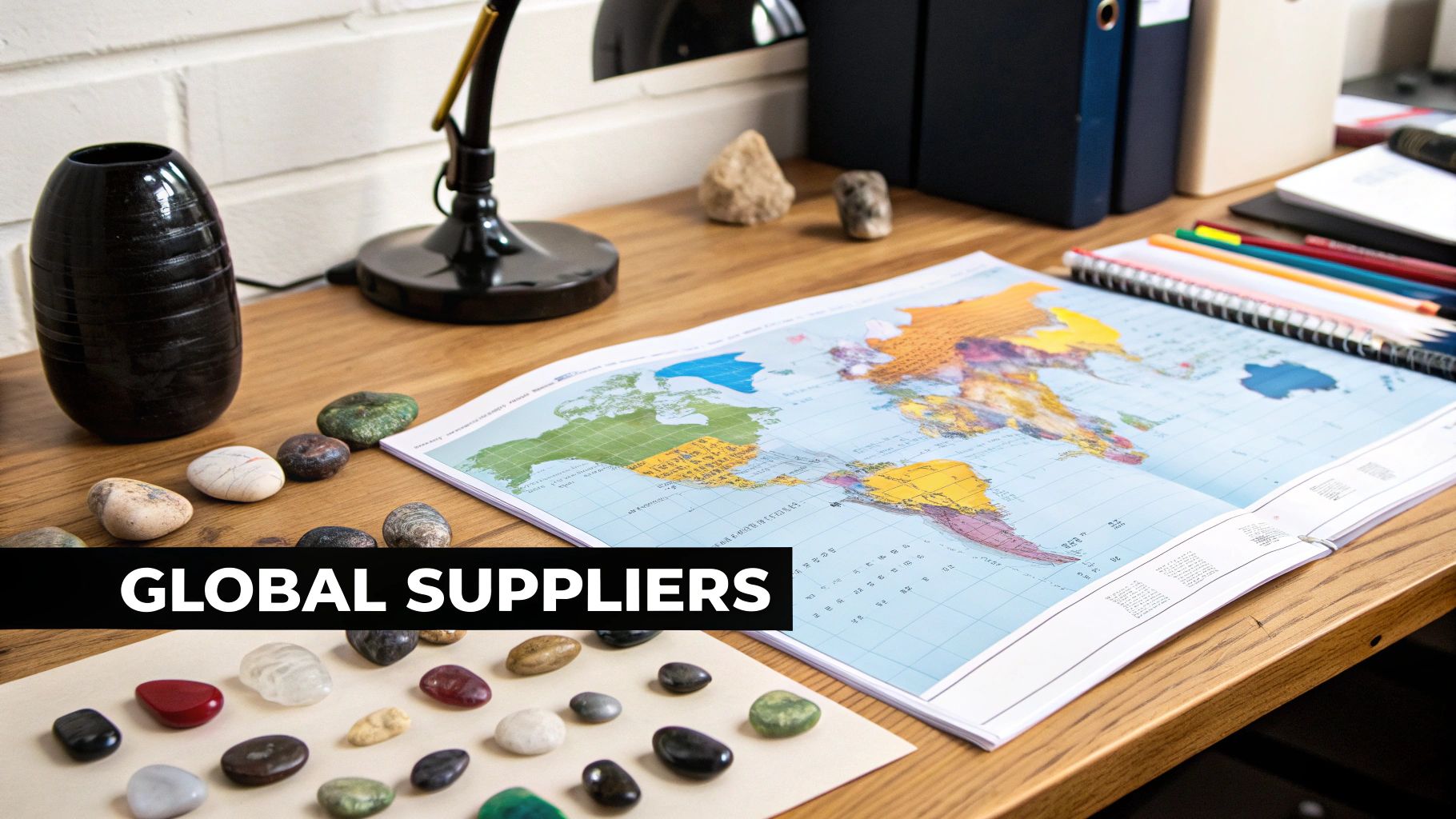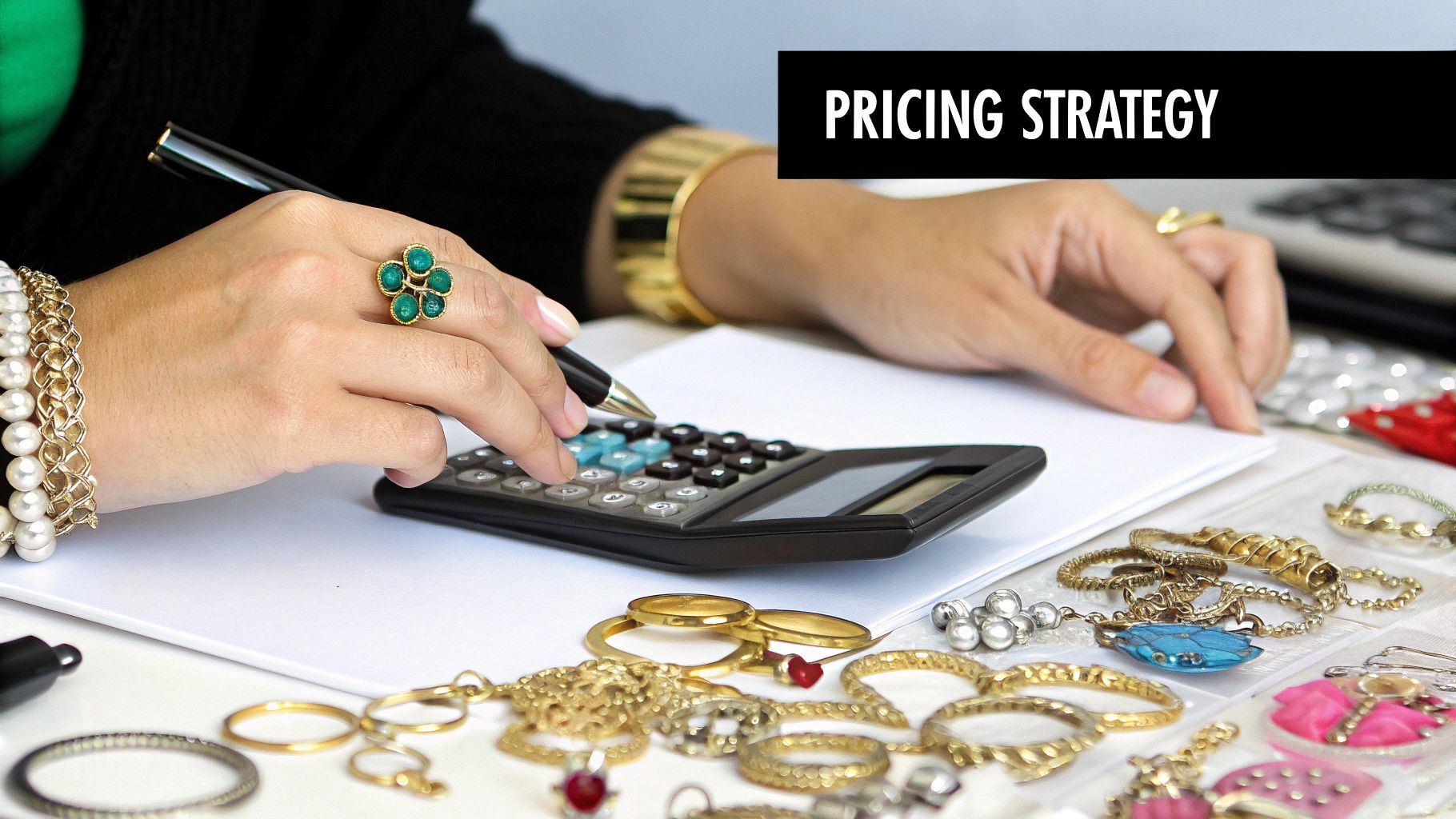Arthur Lynch | Fri Jul 25 2025
A Guide to Wholesale Jewelry for Resale
Diving into the world of wholesale jewelry for resale can be incredibly profitable, but it's a business, not a hobby. To succeed, you need a plan. This guide provides actionable steps for establishing your legal and financial foundation, finding the right suppliers, and pricing your products for maximum profit.
Building Your Jewelry Resale Business Foundation

Jumping into jewelry resale is thrilling, but what separates successful boutiques from fizzled-out side hustles is the groundwork. Before you even look at a supplier's catalog, you need to build a solid operational and financial framework. This initial planning is the most critical step you'll take.
The opportunity is massive. The global jewelry market is valued at around $348 billion as of 2025, and it's growing by about 5.2% each year. The wholesale market is the engine driving that growth. You can discover more jewelry industry trends and statistics to understand the potential.
Define Your Niche and Target Audience
You cannot be everything to everyone. A generic jewelry store struggles to connect with any specific audience. To build a strong brand, you must define your niche.
Start by identifying a specific customer profile and their style. Here are a few actionable niche ideas:
- Minimalist & Dainty Jewelry: Target young professionals with delicate, everyday pieces.
- Bohemian & Festival-Ready: Curate bold, layered items for a free-spirited crowd.
- Bridal & Special Occasion: Specialize in elegant earrings, necklaces, and bracelets for formal events.
- Ethically Sourced & Sustainable: Focus on conscious consumers with jewelry made from recycled metals and ethically sourced stones.
To validate your niche, perform market research. Go to Pinterest, TikTok, and Instagram and search for your niche keywords. Look for styles with high engagement that aren't widely available at affordable price points. That intersection is your opportunity.
Expert Tip: To get ahead of trends, monitor high-fashion runway shows. Emerging themes often transition to mainstream fashion within 6-12 months. Sourcing based on these predictions gives you a significant competitive advantage.
Secure Your Legal and Financial Footing
To operate legally and professionally, take these two steps immediately:
- Obtain a Resale Certificate: This document (also called a seller's permit or reseller's license) is non-negotiable. Legitimate wholesalers require it to sell to you tax-free, as you will be responsible for collecting sales tax from your end customers. Contact your state's Department of Revenue or taxation office to apply.
- Create a Detailed Budget: Avoid overspending by mapping out all potential costs in a spreadsheet before you buy anything.
Your initial budget must include these specific line items:
- Initial Inventory: The cost of your first bulk jewelry purchase.
- Business Fees: Costs for your business license and resale certificate.
- Platform Fees: Monthly subscriptions for e-commerce sites like Shopify or listing fees on marketplaces like Etsy.
- Shipping & Packaging: Factor in boxes, mailers, bubble wrap, thank-you cards, and branded materials.
- Marketing & Photography: Allocate a budget for social media ads or professional product photos to drive initial sales.
A clear financial plan is not optional; it's the framework that enables you to run your business with confidence and profitability from day one.
How to Find and Vet Wholesale Jewelry Suppliers
Finding the right wholesale supplier is the most important relationship you will build. A great supplier is a partner who impacts your product quality, pricing, and brand reputation. Go beyond a simple Google search to find reliable partners who align with your business goals.
Where to Look for Wholesale Partners
There are several effective channels for discovering potential suppliers. Here’s a breakdown of where to focus your search:
Online B2B Marketplaces
Start your search on specialized online B2B platforms like Faire and FashionGo. These marketplaces are designed for retailers and often feature low or no minimum order requirements (MOQs), which is ideal for new businesses. They provide a secure environment and a large, vetted directory of suppliers.
Industry Trade Shows
To assess quality firsthand, attend industry trade shows. Major events like the JCK show in Las Vegas or the Tucson Gem and Jewelry Show allow you to meet suppliers, handle products, and identify emerging trends before they become mainstream.
Community and Direct Sourcing
Join Facebook groups or Reddit forums for boutique owners. Members often share honest reviews and recommend trusted suppliers. For more established businesses, sourcing directly from manufacturers can significantly reduce costs, though it requires larger order volumes and more complex logistics.
This direct interaction can yield insights you won't find anywhere else.
Comparing Sourcing Channels for Wholesale Suppliers
Use this table to decide which sourcing channel best fits your business stage and goals.
| Sourcing Channel | Pros | Cons | Best For |
|---|---|---|---|
| Online B2B Marketplaces | Huge selection, vetted suppliers, low MOQs, buyer protection. | Can be competitive, transaction fees may apply. | New and small businesses needing flexibility and security. |
| Industry Trade Shows | See products in person, build relationships, discover trends. | Can be expensive (travel, tickets), time-consuming. | Retailers who want to build strong relationships and assess quality firsthand. |
| Industry Directories | Access to established, reputable suppliers, less "noise". | Can be outdated, may require more outreach effort. | Businesses looking for long-term, stable supplier relationships. |
| Social Media/Forums | Honest, real-world reviews and recommendations from peers. | Information can be unverified, requires active participation. | Anyone looking for peer-to-peer insights and hidden gems. |
| Direct Factory Sourcing | Lowest per-unit cost, potential for customization. | High MOQs, complex logistics, communication barriers. | Established businesses with high sales volume and experience. |
A practical strategy is to use a hybrid approach: start on a B2B marketplace to find initial suppliers, then attend a trade show to meet them in person and solidify the relationship.
The Essential Vetting Checklist
Once you have a shortlist of potential suppliers, you must vet them rigorously. A great partner offers more than just low prices.

Never commit to a large order without performing due diligence. Use this checklist for every potential supplier:
- Minimum Order Quantity (MOQ): Confirm their MOQ. Is it a dollar amount or a number of units? Ask if they are willing to provide a smaller test order for a new retail partner. Many will agree.
- Product Quality & Materials: Ask for specifics. Inquire about base metals, plating thickness (e.g., 18k gold over sterling silver), and stone types. A transparent supplier is a good sign. For example, if you're sourcing necklaces, you need high-quality gold-plated necklaces from a wholesale supplier that meet your brand's standards.
- Shipping & Logistics: Ask where they ship from, their average lead times, and shipping costs. Reliable shipping is critical for inventory management.
- Return & Damage Policy: Understand their process for handling damaged goods or quality issues. A clear and fair return policy is a sign that the supplier stands behind their product.
My Biggest Piece of Advice: Always place a small sample order before committing to a large purchase. This is the only way to accurately judge product quality, compare it to photos, and test their shipping efficiency.
Watch for red flags like slow communication, inconsistent product photos, or vague answers about policies. A strong partnership requires trust and transparency to ensure you get a reliable supply of quality wholesale jewelry for resale.
Selecting and Evaluating Profitable Jewelry Pieces

Choosing the right products is a strategic process of evaluating materials, identifying trends, and building a cohesive collection. Your expertise in curating a compelling inventory is what builds a profitable wholesale jewelry for resale business.
Your selection process starts with a deep understanding of the materials you are buying, as this directly impacts quality, price, and how you market your items.
Decoding Materials and Assessing Craftsmanship
To price items correctly and market them honestly, you must understand the materials. Here is a practical guide to the most common options in the wholesale market:
- Sterling Silver (.925): A high-quality choice made of 92.5% pure silver. It's durable, has a classic bright finish, and is often hypoallergenic—a key selling point. Always verify authenticity by looking for the ".925" stamp.
- Gold-Plated vs. Gold-Filled: These are not the same. Gold-plated jewelry has a thin layer of gold over a base metal (like brass), making it affordable but prone to tarnishing. Gold-filled jewelry has a much thicker layer of gold heat-bonded to the base, making it far more durable and tarnish-resistant. For lasting quality, choose gold-filled.
- Stainless Steel: An extremely durable, hypoallergenic material that won't tarnish or rust. It is an excellent choice for everyday wear and is popular in minimalist and contemporary designs.
Look beyond the material to the craftsmanship. Inspect clasps to ensure they are secure. Check that gemstone settings are even. Poor finishing is a clear indicator of low-quality production and can damage your brand's reputation.
My Two Cents: Never rely solely on supplier photos. Order samples and conduct hands-on testing. Wear a necklace for several days to check for discoloration. See if a ring turns your finger green. This is the only way to be certain of the quality you pass on to your customers.
Spotting Trends and Building a Cohesive Collection
A great inventory feels intentionally curated. Your goal is to build a collection with a clear point of view that encourages customers to buy multiple pieces. This requires an eye for current and upcoming trends.
Look beyond your direct competitors. Use TikTok and Instagram for micro-trends, but also analyze fashion publications and runway reports. When you spot emerging themes, like bold organic shapes or colorful enamel, you can source relevant pieces before the market is saturated.
Understanding market segmentation is also crucial. Global sales data shows fine jewelry at 68% of the market, fashion jewelry at 22%, and watches at 10%. Knowing these figures helps you target the largest opportunities. You can explore more jewelry wholesale market dynamics to see how distributors serve these segments.
Instead of chasing random bestsellers, think like a stylist. Take these actionable steps:
- Tell a Story: Curate around a theme, such as "coastal grandmother" with pearls or "downtown edge" with chunky chains. A theme makes shopping more engaging.
- Encourage Layering: A powerful sales tactic. Intentionally source necklaces in varying lengths and bracelets with different textures that are designed to be worn together to increase your average order value.
- Develop a Signature Look: Become the go-to source for a specific aesthetic. This builds a strong brand identity and turns one-time buyers into loyal fans.
This strategic approach transforms your store from a simple reseller into a style destination. If you're interested in creating your own unique designs, you can check out our guide on jewelry making essentials. By building a collection with a clear vision, you ensure your pieces don't just sell—they build a brand.
Pricing and Inventory Strategies for Maximum Profit
Finding beautiful wholesale jewelry is only the first step. Profitability comes from mastering your pricing and inventory management. This is where many new resellers fail, but getting your numbers right is what will make your business sustainable.
The biggest mistake is pricing items based only on the wholesale cost. You must first calculate your landed cost—the true total cost to get a product from the supplier into your hands, ready to sell.
Calculating Your True Product Cost
Your landed cost is the foundation of your pricing strategy. Use this simple formula: Landed Cost = Product Cost + Shipping Fees + Duties/Taxes + Transaction Fees
For example, a necklace with a $5.00 wholesale cost might incur $1.00 in shipping and $0.50 in import duties per piece. Your true landed cost is $6.50, not $5.00. Basing your retail price on the lower number will destroy your profit margin. Always use the full landed cost.
With your true cost, choose a pricing model:
- Keystone Pricing: The industry standard. Double your landed cost to set the retail price (a 100% markup or 50% margin). The $6.50 necklace would be priced at $13.00. This is a solid starting point for most fashion jewelry.
- Value-Based Pricing: Price items based on their perceived value. A unique, high-quality piece might support a 3x or 4x markup, while a more common item might need to stick closer to the keystone price to remain competitive.
My rule of thumb? Target a profit margin between 50% and 75% for most jewelry, which means a 2x to 4x markup on your landed cost. Don't hesitate to price unique or trending pieces at the higher end; customers pay for style and curation, not just materials.
Mastering Inventory Control
A great pricing strategy is useless if your cash is tied up in unsold inventory. Effective inventory management means ensuring you have enough of your bestsellers without accumulating slow-moving stock. You need a system to track what's selling, how fast, and when to reorder.
You don't need expensive software. A simple spreadsheet is your most powerful tool.
Building Your Inventory Tracking System
Create a spreadsheet to track sales velocity with these essential columns:
| Product SKU | Product Name | Landed Cost | Retail Price | Units Sold (Last 30 Days) | Current Stock |
|---|---|---|---|---|---|
| NK-101 | Gold Herringbone Necklace | $8.25 | $24.99 | 15 | 35 |
| ER-205 | Sterling Silver Hoops | $4.50 | $14.99 | 42 | 8 |
| BR-302 | Beaded Charm Bracelet | $6.00 | $18.99 | 5 | 50 |
This dashboard provides an immediate action plan. The Sterling Silver Hoops (ER-205) are bestsellers and need to be reordered immediately. The Beaded Charm Bracelet (BR-302) is a slow mover; put this item on sale to free up capital for products that sell better.
This data-driven approach replaces guesswork with strategy, allowing you to double down on winners and cut losses—the key to maximizing profit in your wholesale jewelry for resale business.
Keeping Up With Modern Trends and Technology

To stay competitive, you must understand where the market is headed. Embracing current consumer values and new technology will help you attract modern buyers and future-proof your business.
The wholesale jewelry industry is constantly evolving with technology and consumer tastes. With the entire jewelry market valued at an estimated $366.79 billion, innovation is essential for capturing market share. You can read the full research on jewelry market advancements to see how technology is shaping the products available for resale.
Tune Into Conscious Consumerism
Today's shoppers demand transparency about product origins. Sustainability and ethical sourcing are no longer niche concerns; they are core values that drive purchasing decisions.
Take a proactive approach by asking suppliers direct questions:
- Recycled Metals: Do you use recycled sterling silver or gold? This is a powerful selling point.
- Ethical Sourcing: How do you verify that your gemstones are conflict-free? Reputable suppliers should provide this documentation.
- Eco-Friendly Packaging: Can you offer packaging made from recycled or biodegradable materials?
Feature these details prominently in your product descriptions. This is not just transparency; it is intelligent marketing that builds trust and connects with a values-driven customer base.
Pro Tip: Look for clear statements or certifications on a supplier's website regarding their ethical practices. A wholesaler who is proud of their sourcing will advertise it, giving you verifiable claims to share with your customers.
Take Advantage of New Technology
Technology is revolutionizing jewelry manufacturing and design. By embracing these advancements, you can offer unique products that set your store apart.
3D printing is a key innovation, enabling manufacturers to create intricate and customized designs that were previously too expensive for wholesale. Sourcing a collection of 3D-printed geometric earrings, for example, can provide an exclusive offering that customers cannot find elsewhere.
"Smart jewelry" is another emerging category to watch. These pieces blend fashion with function, such as rings that track fitness or bracelets that provide notifications. While still a niche market, offering a few curated smart pieces signals that your brand is innovative and forward-thinking.
When sourcing, seek out suppliers who are already embracing these technologies. This could mean finding gemstone jewelry that features unique cuts made possible by new faceting techniques. By incorporating these innovations, you ensure your inventory is not only beautiful but also relevant and exciting to a new generation of shoppers.
Common Questions About Reselling Wholesale Jewelry
Starting a wholesale jewelry for resale business brings up many questions. Getting clear, practical answers is the first step toward building a successful enterprise. Here are the most common questions from new resellers, answered with actionable advice.
How Much Money Do I Need to Start a Jewelry Resale Business?
You can start a jewelry resale business on a lean budget. The exact amount depends on your launch strategy.
For a lean start on a marketplace like Etsy, a budget of $500 to $1,500 is realistic. This will cover your initial inventory, business licensing fees, and basic packaging. This approach minimizes risk while you test the market.
For a more robust launch with your own Shopify store and a dedicated marketing budget, plan for $3,000 to $7,000. This allows for a wider product selection, professional photography, and initial advertising campaigns to drive traffic.
My advice? Start with a smaller, highly curated collection, even if you have more capital. Use your initial sales data to see what works, then reinvest the profits. This data-driven approach is more effective than guessing what will be popular.
What Is a Good Profit Margin for Resale Jewelry?
A healthy and sustainable profit margin for most resale jewelry is between 50% and 75%. This equates to a 2x to 4x markup on your landed cost. This range covers all your operational expenses and ensures a solid net profit.
The ideal markup varies by product type:
- Fashion & Costume Jewelry: For trendy, lower-cost items, a 3x to 4x markup is standard. The higher margin offsets the marketing costs for fast-moving trends and covers items that may fall out of style.
- Fine or High-Quality Jewelry: For items made with sterling silver or gold-filled materials, the cost is higher. A 50% margin (2x markup) is more common, but the higher retail price still yields a strong profit per sale.
Remember to always base your pricing on the true landed cost (including shipping, duties, and fees), not just the wholesale price.
How Do I Handle Minimum Order Quantities?
Minimum Order Quantities (MOQs) can be a hurdle, but they are often negotiable. Don't let a high MOQ from one supplier deter you.
First, simply ask for a lower MOQ. Frame your request as a desire to place a smaller test order to evaluate quality before committing to a larger, long-term partnership. Many suppliers will accommodate new clients.
Second, seek out suppliers that cater to small businesses. Wholesale marketplaces like Faire often feature low or no MOQs. Domestic wholesalers also tend to have more flexible minimums compared to large overseas manufacturers.
At the end of the day, you have to be willing to walk away. It is much better to find a supplier whose terms you can comfortably meet than to overextend your budget on inventory you're not even sure will sell. A good partnership should feel supportive, not stressful.
What Are the Best Platforms to Resell Wholesale Jewelry?
The best platform depends on your brand, audience, and goals. A multi-channel approach is often the most effective strategy for maximizing reach and sales.
Here is a breakdown of the top platforms and their primary advantages:
| Platform | Best For | Key Advantage |
|---|---|---|
| Etsy | Beginners & Niche Brands | Provides access to a massive, built-in audience actively searching for unique jewelry. |
| Shopify | Brand Builders & Scalers | Offers complete control over your brand, customer experience, and data, allowing you to build a long-term asset. |
| Social Commerce (Instagram/TikTok) | Trend-Focused & Visual Brands | Enables you to sell directly to your community, creating a seamless path from discovery to purchase. |
A proven strategy is the hybrid model: build your primary brand on a Shopify store for maximum control and profitability, while also maintaining an Etsy shop to capture its large user base and drive new customers to your main site. This gives your wholesale jewelry for resale business the best of both worlds: true brand ownership and massive reach.
Ready to find high-quality, trend-forward pieces for your new business? JewelryBuyDirect offers direct-from-factory pricing with no minimum order requirements, giving you the ultimate flexibility to build your dream inventory. Explore our collections and start sparkling today.
Article created using Outrank



 to show code
to show code



































































































































